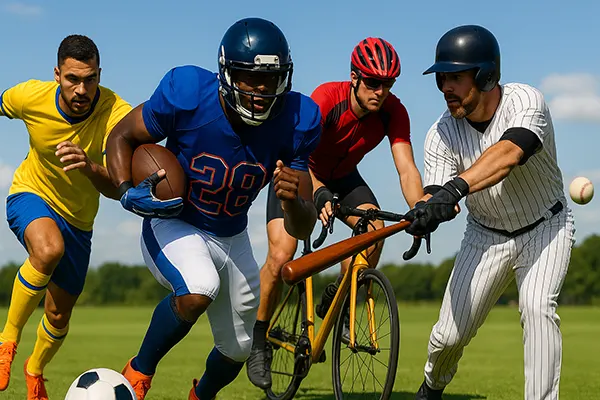
Unexpected Sporting Events of 2025: How Professional Athletes React to Sudden Changes
In the world of sports, unpredictability is a constant factor. Whether it’s a game-changing injury, a sudden change in regulations, or unexpected environmental conditions, professional athletes must continuously adapt to maintain their competitive edge. The year 2025 has already proven to be eventful in this regard, with numerous unforeseen situations impacting various sports. This article delves into some of the most unexpected events and how athletes have reacted to them.
Unforeseen Rule Changes and Their Impact on Athletes
Rule changes can significantly affect the strategies and performance of professional athletes. In 2025, several sports organizations introduced new regulations aimed at enhancing player safety and fair play. While these changes were intended for the greater good, they caught many athletes off guard, forcing them to adapt swiftly.
For example, in football, a new offside interpretation led to confusion among players and coaches alike. Strikers who traditionally played on the edge of the defensive line found themselves more frequently penalized, leading to a shift in attacking strategies. As a result, training sessions increasingly focused on spatial awareness and offside discipline.
Similarly, the introduction of stricter anti-doping regulations in athletics had a direct impact on training routines. Athletes had to ensure that their dietary supplements complied with the updated list of banned substances, requiring increased vigilance and professional guidance. Such changes not only affected individual performance but also altered team dynamics.
Adaptation Strategies of Athletes
Professional athletes have demonstrated remarkable resilience in the face of these challenges. Many have sought guidance from sports psychologists to enhance their mental flexibility, recognizing that adapting to new rules is as much a mental game as a physical one.
Moreover, team coaches have played a pivotal role in helping athletes adjust by organizing workshops and strategy sessions focused on the new regulations. These efforts have not only fostered a deeper understanding of the rules but also promoted a sense of solidarity within teams.
Ultimately, the ability to adapt quickly to rule changes has emerged as a defining trait of successful athletes in 2025, emphasizing the importance of continuous learning and psychological preparedness.
Unexpected Injuries and Their Consequences
Injuries remain one of the most unpredictable aspects of professional sports. In 2025, a series of high-profile injuries have highlighted the fragility of even the most well-prepared athletes. Sudden injuries not only affect individual careers but also disrupt team strategies, often requiring immediate tactical adjustments.
For instance, during the European Basketball Championship, a key player’s unexpected knee injury forced the team to rethink their offensive approach. Coaches had to reorganize the starting lineup and develop new play patterns that compensated for the absence of their star athlete.
Additionally, in combat sports, injuries sustained during practice sessions have led to last-minute substitutions, changing the dynamics of major competitions. Fighters who were scheduled to compete had to quickly alter their game plans to accommodate new opponents with different fighting styles.
Rehabilitation and Mental Recovery
Recovery from unexpected injuries involves not just physical healing but also mental fortitude. Many athletes have turned to advanced physiotherapy techniques combined with psychological counseling to cope with the sudden disruption to their careers.
Sports medicine professionals emphasize the importance of maintaining a positive mindset during rehabilitation. Athletes are encouraged to set short-term recovery goals to stay motivated, even when facing long rehabilitation periods.
Moreover, sharing recovery stories on social media has emerged as a way for athletes to maintain a connection with fans, fostering a supportive community that motivates them to return stronger.

Environmental Factors and Weather-Related Disruptions
In 2025, unpredictable weather patterns have posed new challenges to outdoor sports. From torrential rain during tennis tournaments to unseasonal heatwaves at marathon events, athletes have had to modify their routines and gear to cope with environmental changes.
For example, during the Australian Open, unexpected heatwaves forced tennis players to adopt cooling strategies between sets. This included using ice vests and electrolyte solutions to combat dehydration and heat exhaustion.
Meanwhile, in motor racing, heavy rains during the World Rally Championship caused several crashes, prompting organizers to reassess safety protocols. Drivers were instructed to reduce speed in affected areas, while teams introduced specialized tire treads to improve grip on wet surfaces.
Preparing for the Unpredictable
Environmental unpredictability has pushed athletes to prepare more rigorously for weather disruptions. Training now incorporates simulated conditions, such as practicing in climate-controlled environments to build endurance in adverse weather.
Teams are also investing in portable weather monitoring equipment to make real-time adjustments during competitions. This proactive approach has proven vital in maintaining performance levels despite fluctuating conditions.
Ultimately, the ability to thrive amid environmental challenges has become a crucial aspect of modern athletic training, reinforcing the need for flexibility and innovation in sports.
